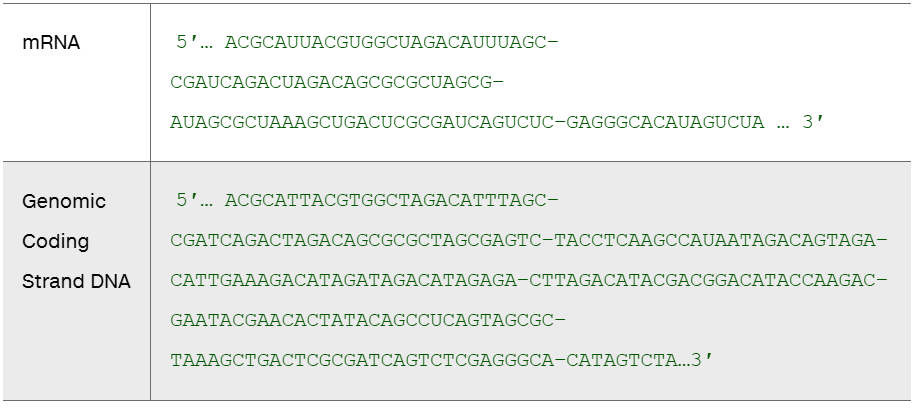Describe the role of two forms of RNA editing that lead to changes in the size and sequence of pre-mRNAs. Briefly describe several examples of each form of editing, including their impact on respective protein products.
Table of contents
- 1. Introduction to Genetics51m
- 2. Mendel's Laws of Inheritance3h 37m
- 3. Extensions to Mendelian Inheritance2h 41m
- 4. Genetic Mapping and Linkage2h 28m
- 5. Genetics of Bacteria and Viruses1h 21m
- 6. Chromosomal Variation1h 48m
- 7. DNA and Chromosome Structure56m
- 8. DNA Replication1h 10m
- 9. Mitosis and Meiosis1h 34m
- 10. Transcription1h 0m
- 11. Translation58m
- 12. Gene Regulation in Prokaryotes1h 19m
- 13. Gene Regulation in Eukaryotes44m
- 14. Genetic Control of Development44m
- 15. Genomes and Genomics1h 50m
- 16. Transposable Elements47m
- 17. Mutation, Repair, and Recombination1h 6m
- 18. Molecular Genetic Tools19m
- 19. Cancer Genetics29m
- 20. Quantitative Genetics1h 26m
- 21. Population Genetics50m
- 22. Evolutionary Genetics29m
10. Transcription
RNA Modification and Processing
Problem 31a
Textbook Question
A portion of a human gene is isolated from the genome and sequenced. The corresponding segment of mRNA is isolated from the cytoplasm of human cells, and it is also sequenced. The nucleic acid strings shown here are from genomic coding strand DNA and the corresponding mRNA.

There is one intron in the DNA sequence shown. Locate the intron and underline the splice site sequences.
 Verified step by step guidance
Verified step by step guidance1
Identify the genomic coding strand DNA sequence and the corresponding mRNA sequence provided in the problem. Note that the mRNA sequence is derived from the coding strand of DNA, with uracil (U) replacing thymine (T).
Compare the genomic coding strand DNA sequence to the mRNA sequence. Look for regions in the DNA sequence that are absent in the mRNA sequence. These regions represent introns, as introns are spliced out during mRNA processing.
Locate the splice site sequences flanking the intron. In eukaryotic genes, introns typically have conserved splice site sequences at their boundaries. The 5' splice site (donor site) often contains the sequence 'GU' at the beginning of the intron, and the 3' splice site (acceptor site) often contains the sequence 'AG' at the end of the intron.
Underline the splice site sequences in the genomic coding strand DNA sequence. Ensure that the identified intron region is flanked by the conserved 'GU' and 'AG' sequences.
Verify your findings by ensuring that the remaining exonic sequences in the genomic coding strand DNA match the mRNA sequence after the intron is removed. This confirms the correct identification of the intron and splice sites.
 Verified video answer for a similar problem:
Verified video answer for a similar problem:This video solution was recommended by our tutors as helpful for the problem above
Video duration:
4mPlay a video:
Was this helpful?
Key Concepts
Here are the essential concepts you must grasp in order to answer the question correctly.
Gene Structure
A gene consists of coding regions (exons) and non-coding regions (introns). Exons are sequences that are expressed in the final mRNA, while introns are removed during RNA processing. Understanding the structure of a gene is crucial for identifying where introns and exons are located within the DNA sequence.
Recommended video:
Guided course

Ribosome Structure
RNA Splicing
RNA splicing is the process by which introns are removed from the pre-mRNA transcript, and exons are joined together to form mature mRNA. This process is essential for the correct expression of genes, as it ensures that only the coding sequences are translated into proteins. Recognizing splice sites is key to understanding how mRNA is processed.
Recommended video:
Nucleotide Sequences
Nucleotide sequences are the building blocks of DNA and RNA, consisting of adenine (A), cytosine (C), guanine (G), and thymine (T) in DNA, and uracil (U) replacing thymine in RNA. Analyzing these sequences allows for the identification of specific regions, such as splice sites, which are critical for understanding gene expression and regulation.
Recommended video:
Guided course

Sanger Sequencing
Related Videos
Related Practice
Textbook Question
507
views



